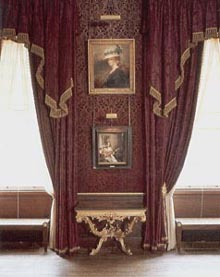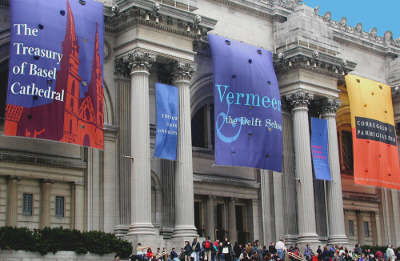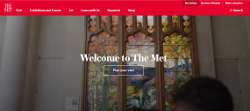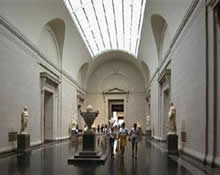By now, almost any self-respecting art institution has digitized some part of its collection. However, the design of the typical "virtual museum" frequently fails to rise above the level of a database intended more for administrative purposes. The artworks are often shown at low resolution if not in thumbnail format, precluding any meaningful experience on the part of internet navigators. Some museums have attempted to reach a wider audience by including custom-made content via some innovative presentation form.Peter Gorgels, "Rijksstudio: Make Your Own Masterpiece!," MW2013: Museums and the Web 2013, The annual conference of Museums and the Web | April 17–20, 2013 | Portland, OR, http://mw2013.museumsandtheweb.com/paper/rijksstudio-make-your-own-masterpiece/ Others have assumed a wait-and-see attitude.

What is certain is that digitalization, which can no longer be postponed, raises existential questions for art institutions. How will the elevated costs of digitalization be recovered? Why go to a museum if you can enjoy the same artworks at your leisure on the nearest computer monitor? By overexposing works of art, will their "aura" be diminished, as Walter Benjamin predicted? Will paintings become "marketing instruments" in the hands of powerful museums? Furthermore, some institutions feel that the loss of the economic control over their intellectual property assets will erode their unquestioned authority as the custodians of the cultural value of the objects they possess and as gatekeepers of authenticity.
The most recent development in digital strategy of artworks of the past is the Open Content Project policy pioneered by the Rijksmuseum, the Getty and the Washington National Gallery of Art. These forward-looking institutions provide not only free access to high-quality images of the objects in their collections of a level unthinkable only a few years ago, but have lifted any copyright restrictions whatsoever in the hopes of encouraging engagement of the general public with art and stimulating contemporary artistic production.
In regards to the Open Content Project recently launched by the Getty, CEO Jim Cuno stated "The Getty was founded on the conviction that understanding art makes the world a better place, and sharing our digital resources is the natural extension of that belief," Thus, the move to offer high-quality images of their artworks free of copyright and fee is "an educational imperative. Artists, students, teachers, writers, and countless others rely on artwork images to learn, tell stories, exchange ideas, and feed their own creativity." In any case, there is little doubt that technological innovation is reshaping the role and mission of museums as producers and distributors digital images exposing them contemporarily to threats and opportunities which are only now coming into view.
Almost all of the institutions which house one or more Vermeer paintings have a website in which their Vermeer works are represented in some way. Some have allotted low quality images and minimum information while other, such as the Rijksmuseum, the Metropolitan of New York and the National Gallery of Washington provide navigators with in-depth information and spectacular high-resolution digital images. Furthermore, a few museum website few provide innovative tools for exploring art history such as timelines and essays on special topics. These sites have been signaled with four or five stars.
It is now possible to download, free of charge digital images of an increasing number of Vermeer paintings.
ATTENTION!
- Please note that the following information is up-to-date as of August 3, 2023 but may have changed since then.
- If you are traveling specifically to see one or more paintings by Vermeer, always contact the museum beforehand to be sure it is on display at the moment you plan to visit. Paintings are frequently on temporary loan or in restoration.
- Keep track of the temporary exhibitions by viewing the complete Vermeer catalogue index.
| part 1 | |
| Rijksmuseum |
Amsterdam, Netherlands |
| New York Metropolitan Museum of Art |
New York, U.S.A. |
| National Gallery of Art
|
Washington D.C., U.S.A. |
| National Gallery
|
London, England |
| part 2 | |
| Mauritshuis |
The Hague |
| Frick Collection |
New York, U.S.A. |
| Musée du Louvre |
Paris, France |
| Staatliche Museen Preußischer Kulturbesitz, Gemäldegalerie |
Berlin, Germany |
| Staatliche Kunstsammlungen, Gemäldegalerie |
Dresden, Germany |
| Städelsches Kunstinstitut |
Frankfurt am Main, Germany |
| part 3 | |
| Herzog Anton Ulrich-Museum |
Brunswick, Germany |
| Kunsthistorisches Museum |
Vienna, Austria |
| National Gallery of Ireland |
Dublin, Ireland |
| Isabella Stewart Gardner Museum (n.g.) | Boston, U.S.A. |
| Kenwood House |
London, England |
| The Royal Collection, Buckingham Palace |
London, England |
| National Gallery of Scotland |
Edinburgh, Scotland |
| The Leiden Collection |
New York, U.S.A. |
RIJKSMUSEUM
museum home page: https://www.rijksmuseum.nl/en




The Rijksmuseum, one of the most renowned museums in the world, was founded in The Hague in 1800 and moved to Amsterdam in 1808. It is dedicated to art, crafts, and history and possesses one of the most significant collection of Dutch Golden Age painings, including works by renowned artists such as Rembrandt van Rijn, Johannes Vermeer, and Frans Hals. One of its most famous pictures is The Night Watch by Rembrandt.
In addition to its paintings, the Rijksmuseum boasts a diverse collection of other objects of both Dutch and Asian origin. It features collections of sculpture and applied arts, including silver, porcelain, furniture, and Dutch Delftware.
There's also a historical collection that provides a picture of Dutch history within a global context and features objects such as models of Dutch ships, historical artifacts, in and archaeological finds.on are works by Frans Hals, Jan Steen and just about every significant Dutch seventeenth-century painter. Vermeer is represented with four absolute masterpieces: The Milkmaid, The Little Street, The Love Letter and the Woman in Blue Reading a Letter.

RIJKSMUSEUM Museum of Art Online

The Rijksmuseum revamped its website in 2022 (Fabrique, Q42, and Irma Boom Office). Besides the new style and visual language, the museum initiated a new platform called Stories, which unveils narratives taking place in the museum and behind the scenes. All texts and interactive items on the website—including clickable buttons and selection menus—are now easily accessible by screen readers and other assistive technologies. The website's content now includes audio descriptions and subtitles. The website also maintains social platforms, Instagram and Twitter. Besides Stories, the key upgrades include user-friendliness and large images.
Perhaps the most valuable resource is the collection of high-resolution images of 125,000 objects (totaling 690 gigabytes) from the museum's vast collection, which can be downloaded to a hard disk (registration required), shared freely, and without copyright restrictions. The Rijksmuseum's images are exceptionally detailed and well-calibrated in color and contrast. The zoom feature allows the user to get a closer look at each work of art, even though obtrusive icons persist. Visitors may be awed when zooming in on the mega-scan of the Woman in Blue Reading a Letter, particularly after its recent restoration. However, they might be disappointed when they download it only to discover a smaller image. The records for each image include important information such as basic object data, exhibition histories, provenance, and related artworks.
In addition to the usual simple and advanced search functions, users can also search the museum's contents by color. Below the high-resolution images, there is a bar displaying six colors, statistically typical for each artwork.. By clicking on one of the colors, users can access objects oin the museum's collection that supposedly possess an abundance of that color. However, there's no distinction between period, maker, place or function of the objects returned.
Following the Vermeer retrospective of 2023, the museum populated their website with a number of excellent features that allow readers to explore the exhibition and the art of Vermeer, which include:
- Get Closer to Vermeer
- Johannes Vermeer: Master of the Everyday
- The Vermeer Exhibition: The Most Successful in its History
- Farewell to Vermeer
In a bid to "democratize" its collection and foster creativity, the Rijksmuseum encourages users to craft their own Rijksstudio. Utilizing straightforward online tools, users can curate their favored artworks and morph them into "products." They have the option to order prints of entire artworks or specific details from them. Moreover, the museum suggests innovative uses for these images—be it fabricating materials to upholster furniture or design wallpaper, crafting tattoos, or adorning a car or an iPad cover. The creative outcomes can be shared with the Rijksmuseum community. As articulated by Taco Dibbits, the Director of Collections, during the Rijksstudio launch, "We have faith in the potency of our masterpieces. We stand by the idea that they are a collective treasure, and that there's a spark of an artist in each one of us."
The strategy of aligning the Rijksmuseum with a spontaneous, do-it-yourself ethos might raise questions regarding its long-term impact—whether it may dilute or enhance the appreciation of art and the museum's remarkable collection. Nonetheless, the open content policy is praiseworthy, with the downloadable images serving as a significant lure for users to revisit the Rijksmuseum website repeatedly.
The website allocates a distinct page for each of its four paintings by Vermeer, encompassing detailed descriptions, a zoom functionality for an in-depth view of each artwork, a concise podcast, and the option to download a high-resolution image:
links:
Rijksmuseum Information
- location: Rijksmuseum the Masterpieces (Philips Wing): Jan Luijkenstraat 1
- opening hours: the Rijksmuseum is open every day from 9:00–18:00. | Fridays open from 9:00 to 22:00 | closed 1 January | Library, Print Room and Reading Room Tuesday to Saturday from 10:00 to 17:00 Identification is required.
- web contact: info@rijksmuseum
- museum bulletin: https://www.rijksmuseum.nl/nl/onderzoek/bulletin
- tickets: Adults: €22,50 / Free for 18 and under / Free for Friends | click here to book tickets.
The Friends of the Rijksmuseum constitute a community of individuals dedicated to supporting the museum through a membership program, with a contribution of €50. By embracing the title of a Friend of the Rijksmuseum, members not only champion the museum and its esteemed collection, but also unlock a suite of exclusive benefits. Here's a glimpse of the perks that come along:
- Unrestricted Access to the Rijksmuseum: Friends can revel in the museum's offerings as often as they wish without worrying about entrance fees.
- Hassle-free Entry to Special Exhibitions: No need to book a time slot; just walk in and explore to your heart's content.
- Invitations to Exclusive Friends' Events: Get a front-row seat to previews of upcoming exhibitions, engaging lectures, and specialized guided tours exclusively curated for Friends
- Retail and Café Discounts: Enjoy a 10% discount at the Rijksmuseum shop and Het Café, making every visit a little more special.
- Subscription to the Rijksmuseum Bulletin: Stay in the loop with the latest happenings and insights directly from the museum.
Please note that the benefits outlined above may have evolved post the publication of this article. For the most up-to-date and precise information regarding the Friends of the Rijksmuseum program, it's recommended to visit the official Rijksmuseum website or get in touch with the museum directly.
Social media: Facebook | Instagram | Twitter
Planning a trip to Amsterdam? Click here.
METROPOLITAN MUSEUM OF ART
museum home page: http://http://www.metmuseum.org/home.asp





Located in the heart of New York City, the museum was founded in 1870 by a group of American citizens who wanted to bring art and art education to the American people.
The museum's collection spans over 5,000 years of world culture, from prehistory to the present and from every part of the globe. It includes more than two million works, divided among seventeen curatorial departments. The collection comprises works of art from classical antiquity and ancient Egypt, paintings, and sculptures from nearly all the European masters, an extensive collection of American and modern art, as well as African, Asian, Oceanic, Byzantine, and Islamic art.
One of The Met's most famous features is the Main Building, located on the eastern edge of Central Park along Manhattan's Museum Mile. It is one of the world's largest art galleries by area. Additionally, The Met Fifth Avenue and The Met Cloisters (which focuses on European medieval architecture, sculpture, and decorative arts) are also part of the museum complex.
The Met also conducts a wide range of educational programs and scholarly initiatives, including exhibitions, guided tours, family programs, and more.

Metropolitan Museum of Art Online

Today, the Metropolitan Museum of Art's website features a vigorous digital presence, offering access to its vast collection and a plethora of online resources. The educational opportunities available are so extensive that encapsulating them within this review would not do them justice. A notable highlight among the online assets is the cutting-edge 'Search the Collection' interface.
Each of Vermeer's five paintings housed in the collection has its own dedicated page. Additionally, four intriguing publications concerning Vermeer are available for online reading or complimentary download.
links:
- A Maid Asleep
- Young Woman with a Water Pitcher
- Woman with a Lute
- Study of a Young Woman
- Allegory of Faith
- Libraries and research
- The Milkmaid by Johannes Vermeer (Walter Liedtke, 2009)
- Vermeer and the Delft School (Walter Liedtke et al., 2001)
- Art and Autoradiography: Insights into the Genesis of Paintings by Rembrandt, Van Dyck, and Vermeer (Maryan Ainsworth et al., 1982)
- "Vermeer's Girl Asleep: A Moral Emblem": Metropolitan Museum Journal, v. 6 (Madlyn Millner Kahr, 1972)
- Timeline of Art History ( First launched in 2000, The Timeline of Art History is a chronological, geographical, and thematic exploration of the history of art from around the world, as illustrated especially by the Museum's collection. The Museum's curatorial, conservation, and education staff-the largest team of art experts anywhere in the world-research. The Timeline, which is an invaluable reference and research tool for students, educators, scholars, and anyone interested in the study of art history and related subjects.)
- Heilbrunn Timeline of Art History: "Johannes Vermeer (1632–1675)"
- Special Exhibition: Vermeer and The Milkmaid
Metropolitan Museum of Art Information
- location: 1000 Fifth Avenue at 82nd Street, New York, New York 10028-0198
general Information: 212-535-7710,TTY: 212-570-3828 or 212-650-2551 - opening hours: Friday 9:30 a.m.–9:00 p.m. | Saturday 9:30 a.m.–9:00 p.m. | Tuesday 9:30 a.m.–5:30 p.m. | Wednesday 9:30 a.m.–5:30 p.m. | Thursday 9:30 a.m.–5:30 p.m. | closed Mondays, January 1, Thanksgiving Day, December 25
- tickets: Adults $30 | Seniors (65 and over) $22 | Students $17 | Children (under 12) Free | Members and patrons Free
Buy tickets here. - email contact page: http://www.metmuseum.org/visit/contact
- social media: Facebook | Instagram | Twitter
NATIONAL GALLERY OF ART
website home page: http://http://www.nga.gov/content/ngaweb.html




Often referred to as the NGA, the National Gallery of art is an American museum created for the people of the United States of America by a joint resolution of Congress, and is a part of the federally operated Smithsonian Institution system. It is located at the east end of the Mall, Washington, D.C. It was founded in 1937 when the financier and philanthropist Andrew W. Mellon donated to the government a collection of paintings by European masters and a large sum of money to construct the gallery's Neoclassical building, which was designed by the architect John Russell Pope, and opened in 1941.

The West Building, composed of pink Tennessee marble, houses an extensive collection of European paintings and sculpture from the Middle Ages through the 19th century, as well as American art from colonial times to the early 20th century. The collection includes masterpieces of such artists as Vermeer, Rembrandt van Rijn, Leonardo da Vinci, Botticelli, and Fra Angelico.
One of the NGA's notable features is its commitment to accessibility, offering a variety of educational programs, lectures, tours, and has a significant digital presence that allows people around the world to access and study its collection.
National Gallery of Art Online

The Metropolitan Museum of Art's website underwent a redesign in 2011, where the museum collaborated with design firms to enhance the digital experience for its online visitors. Some notable features from this redesign included improved navigation, a new color palette, and an elegant, clean design to provide a more engaging and user-friendly experience. The redesign also aimed at better reflecting the museum's brand and enhancing the online visitor's connection to the art and exhibitions. In another update, around 2020, the museum released a new feature, "Stories," which showcases stories happening in the museum and behind the scenes. The website also has been made more accessible for users with disabilities, with screen readers and other assistive technologies now being able to clearly detect all texts and interactive items. Another significant feature is the collection of high-resolution images of 125,000 objects (totaling 690 gigabytes) from the museum's vast collection, which can be downloaded onto one's hard disk (registration required) and shared, free of charge and without copyright restrictions.
One of the most powerful assets of the museum's website is the Search the Collection interface, which opens the door to more than 375,000 images of artworks from the collection for use, sharing, and remixing—without restriction. For example, a simple unfiltered search for "Netherlands" returns 4,905 results. The highly efficient interface boasts numerous features that will satisfy both the most exigent researcher and the curious layman, easily locating any artwork in the collection. Many objects are illustrated by high-quality digital images—many of which can be zoomed in—along with important information including basic object data (otherwise known as tombstone data), exhibition histories, provenance, related artworks, copyright status, maker, date, culture, medium, and dimensions that the Museum has digitized to date. Moreover, this data is now available as a downloadable file on GitHub. By making this information available in a clear, machine-readable format, the Metropolitan's goal is to facilitate research, inspire creativity, and promote exploration of the breadth and depth of the Museum's collection. A dedicated API is forthcoming.
Among the Gallery's many online resources are:
- Search the Collection
- Conservation
- Library
- Archives
- The Center
- Film Programs
- Music Programs
- Audio/Video
Since the museum's audience comprises the three billion internet-connected individuals worldwide, the museum's stated goal is to reach these viewers and increase focus on those digital tactics that have the greatest impact. Open Access is one of those tactics.
In February 2017, The Met, like other forward-looking cultural institutions, introduced an Open Access Initiative, which makes all images of public-domain artworks and basic data on all accessioned works in its collection available for unrestricted use under Creative Commons Zero (CC0). This policy change represented an important milestone in The Met's digital evolution, and a strong statement about increasing access to the collection and how to fulfill the Museum's mission in a digital age. Currently, there are more than 50,000 images under Creative Commons policy that can be downloaded free of charge for any use, commercial or non-commercial—you do not need to contact the National Gallery for authorization to use these images.
This Open Access Initiative represents a body of ongoing work by curators, conservators, photographers, librarians, cataloguers, interns, and technologists over the past 151 years of the institution's history—new images and data are added each year.
The Museum has also launched Stories, intended as inspiration and insights into art, creativity, and our shared humanity.
links:
- Woman Holding a Balance
- A Lady Writing
- Girl with a Red Hat
- Girl with a Flute
- Woman Holding a Balance (PDF file with full information on painting)
- A Lady Writing (PDF file with full information on painting)
- Girl with a Red Hat (PDF file with full information on painting)
- Girl with a Flute (PDF file with full information on painting)
- NGA Images
- Search the collection
National Gallery of Art Information
- location: National Mall between Third and Seventh Streets at Constitution Avenue, NW
- opening hours: Monday through Saturday from 10:00 a.m. to 5:00 p.m. and Sunday from 11:00 a.m. to 6:00 p.m. The Gallery is closed on December 25 and January 1.
- mailing address: 2000B South Club Drive, Landover, MD 20785
tel. (202) 842-6690 - web site newsletter: send an e-mail to webnews@nga.gov with the word "subscribe" in the subject field and you will be automatically signed up for the NGA site newsletter.
- current exhibitions: http://www.nga.gov/exhibitions/index.shtm
- curatorial records (NGA collection questions only): curatorial-records@nga.gov
- gallery archives: gallery-archives@nga.gov
- social media: Facebook | Instagram | Twitter
THE NATIONAL GALLERY
museum home page: http://www.nationalgallery.org.uk/default.htm


The National Gallery in London, boasting one of the most extraordinary collections of European art globally, houses the national collection of Western European painting with over 2,300 pictures dating from 1250 to 1900. This collection includes two Vermeers: A Lady Standing at a Virginal and A Lady Seated at a Virginal. The gallery's website offers a number of very interesting features, and visitors may also subscribe to a newsletter.
The Gallery was founded in 1824 and belongs to the government on behalf of the British public. Entry to the main collection is free of charge.
The Gallery’s national significance is highlighted by its prominent location in central London and its neoclassical architecture. The facade, designed by William Wilkins, is an iconic London landmark.
The collection includes many famous works, such as van Eyck’s Arnolfini Portrait, Velázquez’s Rokeby Venus, Turner’s Fighting Temeraire, and Van Gogh’s Sunflowers. All major traditions of Western European painting are represented, from the artists of late medieval and Renaissance Italy to the French Impressionists.
National Gallery Museum Information
- if you need to check if a particualr work of art is on display:
phone 020 7747 2885 or email information@ng-london.org.uk - location: Trafalgar Square, London WC2N 5DN
- opening hours: open daily 10 a.m.–6 p.m. | Friday until 9 p.m. | closed 24–26 December and 1 January
- entrance: free of charge
- contact: tel: 020 7747 2885 including Typetalk. fax: 020 7747 2423.
- email: curatorial-records@nga.gov email enquiries will usually be responded to within ten working days, Mondays to Fridays only
- social media: Facebook | Instagram | Twitter
Planning a trip to London? Click here.